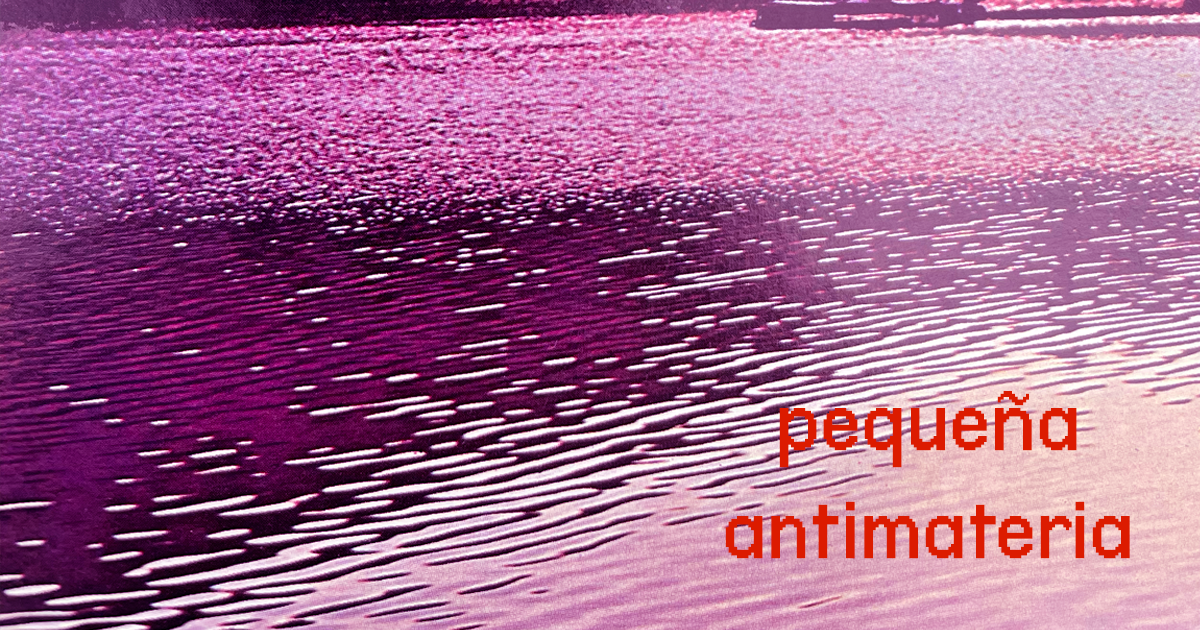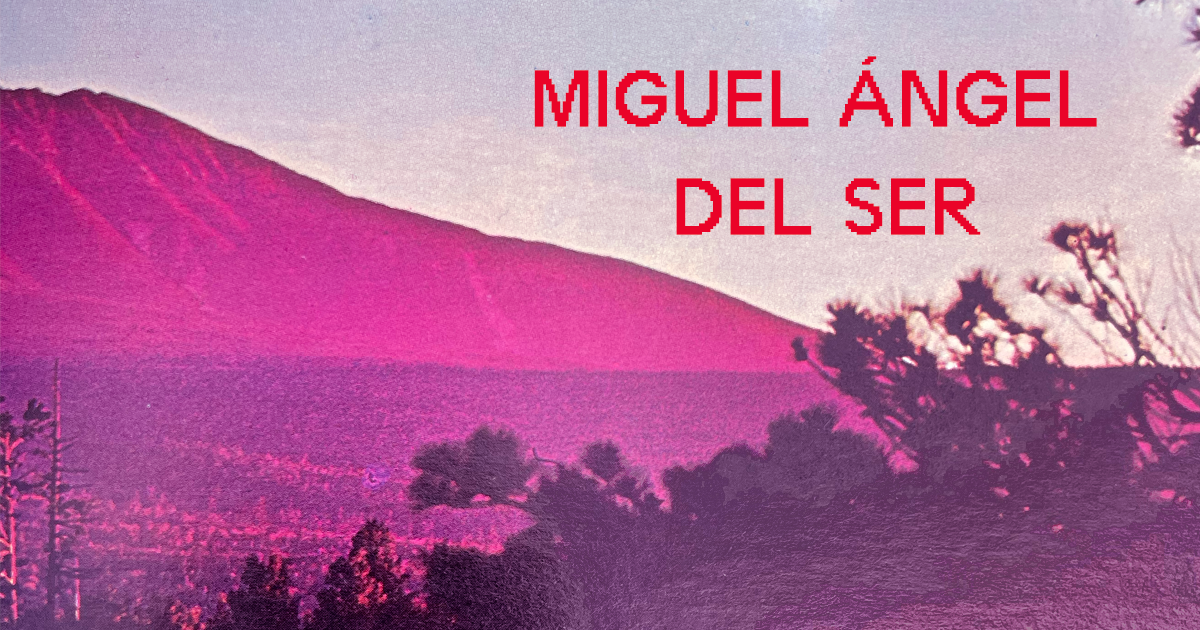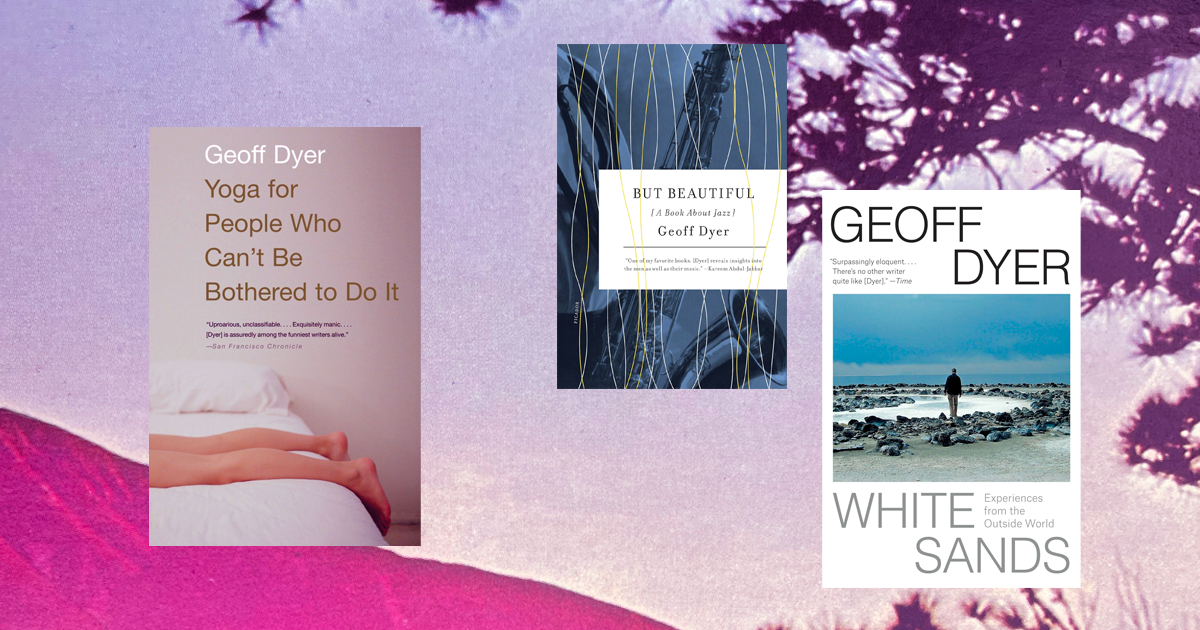
Pequeña Antimateria es un espacio entusiasmado, alucinado, constructivo, anti edadista y feminista donde expandir y romper las ondas de nuestro algoritmo.

En esta PAM 022 nos acompaña Miguel Angel del Ser, curtido en mil batallas en la organización de conciertos y acciones artísticas. Michi también ha sido una parte esencial del underground estatal tocando en bandas como los Venereans o Cubano Vale y formando parte del colectivo independiente La Cúpula del Trueno. Quizá le habéis leído en su blog Psicolabio o colaborando en fanzines y revistas culturales como Artes y Letras. Generoso, bondadoso y muy curioso, siempre es un placer escucharle.
In this PAM 022, we are joined by Miguel Angel del Ser, a veteran of organizing concerts and events across various artistic disciplines. Michi has also been an essential part of the underground scene, playing in bands like Los Venereans and Cubano Vale, and being part of the independent collective La Cúpula del Trueno. You might have read his writings in his blog Psicolabio or cultural magazines and zines such as Artes y Letras. Generous, kind, and very curious, it is always a pleasure to listen to him. Enjoy it!


ITEM #1 Yoga for people who hate yoga/ White sands / But beautiful
Tan grato es recomendar como ser recomendado, y más si es con acierto. Una buena amiga, que me conoce muy bien, me regaló hace unos años "Yoga for People Who Can't Be Bothered to Do It" , un título que me encantó casi tanto como me gusta el yoga. No conocía absolutamente nada del escritor, Geoff Dyer, del mismomodo que todo el mundo al que le recomiendo a este autor, que mira desde la frontera de los géneros tocando ensayo, crítica de arte, novela de ficción y a veces todos mezclados en un mismo libro, lo desconoce. Quizá sea más popular en el Reino Unido, donde ha recibido varios premios.
"Yoga for People Who Can't Be Bothered to Do It" es tan divertido como interesante es su punto de vista. Es una especie de anti libro de viajes, en el sentido de que su voz no habla en tono panegírico de la experiencia del viajar, no es iniciático en absoluto, evita la cursilería del exotismo y no mitifica el alejamiento del mundo occidental, que podrían ser algunas de las más comunes narrativas en este tipo de textos que abordan al hombre blanco en territorios remotos e icónicos.
Con un poso de erudición que nunca es pedante sino genuino fruto del amor por la lectura alrededor del arte y la literatura, Dyer habla de la decepción, de los espacios aburridos, de la mala experiencia que puede ser intentar sacar "esa" foto del amanecer o la puesta de sol con la silueta del templo oriental
mostrando su perfil. Cuenta la decepción con unas de las mejores armas de autodefensa que tenemos para afrontar la frustración: el sentido del humor, y el vitalismo. Aunque la sensación de insuficiencia forma parte de la experiencia de la vida, Dyer nunca es un cenizo, más bien le gustaría vivir muchísimos años para ver si los humanos hemos conseguido resolver esa cosa tan rara que nos estamos montando en eso del existir.
"White Sands" no sé si lo pensó emparejado con Yoga for people...., pero el estilo es similar. Mezcla crítica de arte, experiencia vital, reflexión, emociones, y narrativa. Éste me parece aún más rico en contenido, contándonos "experiencias en el mundo exterior" (su subtítulo) que van de Tahití, investigando a Gauguin desde la actualidad y desmontándolo, a un fin de semana habitando el maravilloso "Lightning Field" del artista minimalista-conceptual-land art además de baterista de la Velvet, Walter de María. Son dos de los textos de crítica de arte que más me han inspirado en mucho tiempo.
Creo que este libro es aún más atractivo que el primero porque el pensamiento que lo atraviesa gira alrededor del entender por qué visitamos a los sitios a los que nos desplazamos, y cómo los habitamos temporalmente. Qué nos mueve a considerar un sitio digno de ser mirado, sentido y pensado. Por qué ponemos tanto interés, emociones y anticipación en esos viajes.
Aprovecho para recomendar, tambíén, "But beautiful" un libro sobre Jazz, con posibles episodios verdaderos, pero también quizá inventados, alrededor de los cuales arma historias completamente formidables y se transforma en una deliciosa lectura moderna, no académica pero estudiosa y fascinante, de los artistas primarios y secundarios, lugares, modos de vivir y cultura alrededor de esta música.
It's as pleasant to recommend as it is to be recommended, especially when done well. A good friend who knows me very well gave me "Yoga for People Who Can't Be Bothered to Do It" a few years ago, a title that I loved almost as much as I love yoga. I knew absolutely nothing about the writer, Geoff Dyer, just as everyone I recommend this author to, who writes from the boundary of genres, touching on essay, art criticism, fiction, and sometimes all mixed into one book, also doesn't know him. He might be more popular in the United Kingdom, where he has received several awards.
"Yoga for People Who Can't Be Bothered to Do It" is as funny as it is interesting in its perspective. It’s a kind of anti-travel book in the sense that his voice doesn't speak in a laudatory tone about the experience of travel, it is not initiatory at all, avoids the sentimentality of exoticism, and doesn’t mythologize distancing oneself from the Western world, which could be some of the more common narratives in texts that address the white man in remote and iconic territories.
With a depth of erudition that is never pedantic but rather a genuine result of a love for reading around art and literature, Dyer talks about disappointment, boring places, and the bad experience of trying to capture "that" photo of the sunrise or sunset with the silhouette of the oriental temple in profile. He addresses disappointment with one of the best self-defense weapons we have for facing frustration: humor and vitality. Although the feeling of inadequacy is part of the experience of life, Dyer is never a downer; rather, he would like to live many years to see if humans have managed to solve this strange thing we're building in existence.
"White Sands," I don't know if he intended it to be paired with "Yoga for People...," but the style is similar. It mixes art criticism, life experience, reflection, emotions, and narrative. This one seems even richer in content, telling us about "experiences in the outside world" (its subtitle) that range from Tahiti, investigating Gauguin from a current perspective and deconstructing him, to a weekend inhabiting the wonderful "Lightning Field" by minimalist-conceptual-land artist and Velvet drummer Walter De Maria. These are two of the most inspiring pieces of art criticism I've read in a long time.
I think this book is even more attractive than the first one because the thought that runs through it revolves around understanding why we visit the places we travel to and how we temporarily inhabit them. What moves us to consider a place worthy of being seen, felt, and thought about it. Why do we put so much interest, emotion, and anticipation into these trips?
I also take this opportunity to recommend "But Beautiful," a book about jazz, with possible true episodes, but perhaps invented, around which he builds completely formidable stories. It transforms into a delightful modern read, not academic but studied and fascinating, about the primary and secondary artists, places, lifestyles, and culture surrounding this music.

ITEM #2 Chantal Akerman
Una estupenda experiencia en el mundo exterior tuve en un reciente viaje a Barcelona, visitando la interesantísima exposición "Attuning" de la videoartista Aura Satz (que también recomiendo enfáticamente) comisarida por Carolina Jiménez. Dando sencillos y poco apresurados paseos enfocados precisamente a hitos de la produccion artísitica, museos y algo de arquitectura, un cartel captó mi atención en la Plaza de Catalunya: hacían una expo de Chantal Akerman en La Virreina Centre de la Imatge. Yo no conocía absolutamente nada de Chantal Akerman, pero me llamaba, sospechaba que podía ser interesante. Así que allá que fuimos, ya cansados y con el tiempo justo para pasear por la expo casi como se pasea por un jardín. Pese a la estrechez horaria pudimos disfrutarla enormememente, teniendo la suerte de ver "Yo, tu, él, ella" en su versión para museo, con la triple proyección simultánea y no correlativa, como está en Filmin. El impacto fue instantáneo, al salir me quería comprar el catálogo, pero en este museo no editan.
Sí tenían, no obstante, un interesante objeto disponible, un pequeño folleto que resultó ser una lectura deslumbrante. No hablaba directamente de Akerman, no había biografía ni comentarios sobre las obras expuestas, no respondía en absoluto al formato al uso. Era simple, pero no sencillamente, una entrevista con su montadora y colaboradora artística durante 30 años Claire Atherton. Ya con su primera respuesta me dí cuenta de que lo que seguía iba a ser formidable y no defraudó. Qué amplísimas inteligencia, sensibilidad, personalidad, forma de estar en el mundo y de trabajar. Ni siquiera tuvo entrevista de trabajo con Ackerman: su conexión fue casi inmediata. Es así que empezaron a generar sus películas casi como si de entidades vivientes se tratase, dejándolas ser, hacerse, permitiendo que el proceso fuera definiendo el camino. Siendo "más radicales" en su forma de practicar el cine, según ellas mismas se decían. El resultado es potentísimo: la escena de la cola del pan en D'Sud lleva rondándome la cabeza desde que ví la película, parece respirar al compás que respira la vida real sin ser realmente un documental. La elección de dejar el sonido original sin subtítulos, de dar espacio al vacío, interrumpido por los gruñidos de aburrimiento esperando una estática pero inquieta cola en un idioma que no entendemos pero cuyo contenido sí entendemos es acertadísima. Crean una narración sin la arquitectura de las narraciones. Una delicia absorbente, hipnótica, emocional, incluso relajante, yo sentí paz viéndola.
Ví 6 películas de Akerman un solo fin de semana tras conocer a esta pareja creativa. Vaya festival.
A wonderful experience in the outside world occurred during a recent trip to Barcelona, where I visited the very interesting exhibition "Attuning" by video artist Aura Satz (which I also emphatically recommend) curated by Carolina Jiménez. Taking simple and unhurried walks focused precisely on artistic production landmarks, museums, and some architecture, a poster caught my attention in Plaza de Catalunya: there was an exhibition of Chantal Akerman at the Virrey Museum. I knew absolutely nothing about Chantal Akerman, but it intrigued me; I suspected it could be interesting. So we went there, already tired and with just enough time to stroll through the exhibition almost as one strolls through a garden. Despite the time constraints, we were able to enjoy it immensely, having the good fortune to see "Je, Tu, Il, Elle" in its museum version, with the triple simultaneous and non-correlative projection, unlike how it is on Filmin. The impact was instant; upon leaving, I wanted to buy the catalog, but this museum doesn't publish them.
They did have, however, an interesting item available, a small booklet that turned out to be a dazzling read. It didn't speak directly about Akerman; there was no biography or comments on the works exhibited, it didn't follow the usual format at all. It was simply, but not simplistically, an interview with her editor and artistic collaborator of 30 years, Claire Atherton. With her first response, I realized that what followed was going to be formidable, and it did not disappoint. What an expansive intelligence, sensitivity, personality, way of being in the world, and way of working. She didn't even have a job interview with Akerman: their connection was almost immediate. This is how they began to create their films almost as if they were living entities, letting them be, allowing the process to define the path. Being "more radical" in their way of practicing cinema, as they said. The result is immensely powerful: the breadline scene in "D'Est" has been lingering in my mind since I saw the film, it seems to breathe in rhythm with real life without actually being a documentary. The choice to leave the original sound without subtitles, to give space to the void, interrupted by the grunts of boredom while waiting in a static but restless line in a language we don't understand but whose content we do understand is very apt. They create a narrative without the architecture of narratives. An absorbing, hypnotic, emotional, and even relaxing delight—I felt peace watching it.
I watched six Akerman films in one weekend after discovering this creative duo. What a festival!

ITEM #03 Eva Svankmajerova
Por ultimo recomiendo a la mitad menos conocida de otra pareja artística y sentimental maravillosa (en sentidos literal y surrealista): Eva Svankmajerova, escenógrafa teatral, pintora, escritora, escultora y figura activa de la fértil cultura surrealista checa habiendo colaborado regularmente con poesía y prosa para la revista surrealista Analogon. Además, claro, era la mujer del conocido y fascinante artista y director de cine Jan Svankmajer, con quien trabajó en una estrecha relación creativa que nos ha dejado un auténtico manantial de joyas.
Son escasos son los textos que hay sobre ella, acabándose de editar hace poco un libro sobre su obra acerca del cual pregunté en una librería checa y recibí la habitual respuesta ante la búsqueda de literatura surrealista de ese país, "sorry, not in english yet". Nos queda su obra: el delirante libro "Baradla Cave" -del que sí hay versión en inglés- y lo que podemos observar dentro de las películas de Svankmajer como sus pinturas, fantásticas escenografías, figuras de arcilla (imposible no recomendar aquí "Dimensions of dialogue", simbólico y metafórico cortometraje sobre la incomunicación entre humanos), y por supuesto internet, donde podremos ver algunos de sus cuadros. En Praga al parecer se puede visitar la casa de ambos, además de la Galería Nacional de Arte; no dejo de soñar con tener la oportunidad de poder transitar una Praga sin turistas, empapándome de toda la cultura alquímica, esotérica y surrealista que habita en la ciudad.
Lastly, I recommend the lesser-known half of another wonderful artistic and romantic duo (in both literal and surreal senses): Eva Švankmajerová. She was a theater set designer, painter, writer, sculptor, and an active figure in the fertile Czech surrealist culture, regularly contributing poetry and prose to the surrealist magazine Analogon. Additionally, she was, of course, the wife of the well-known and fascinating artist and film director Jan Švankmajer, with whom she worked in a close creative relationship that has left us with a true wealth of treasures.
There are few texts about her; a book about her work was recently published, which I inquired about in a Czech bookstore and received the usual response when seeking out surrealist literature from that country, "Sorry, not in English yet." We have her work: the delirious book "Baradla Cave" (which does have an English version) and what we can observe in Švankmajer's films, such as her paintings, fantastic sets, clay figures (it is impossible not to recommend "Dimensions of Dialogue" here, a symbolic and metaphorical short film about human miscommunication), and of course, the internet, where we can see some of her paintings. In Prague, looks like you can visit their house, as well as the National Gallery of Art; I can't stop dreaming of having the opportunity to wander through a tourist-free Prague, soaking in all the alchemical, esoteric, and surrealist culture that inhabits the city.
